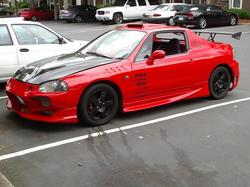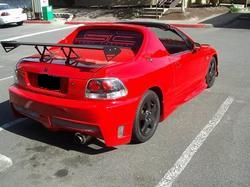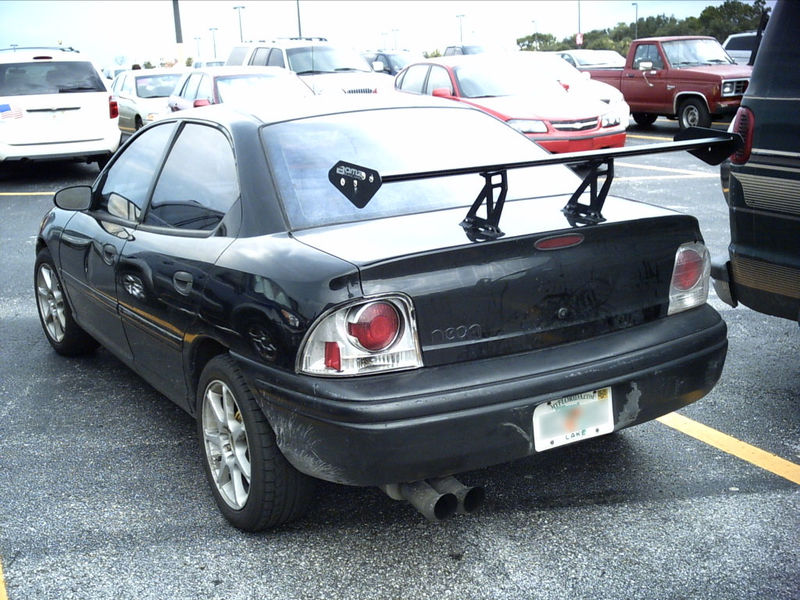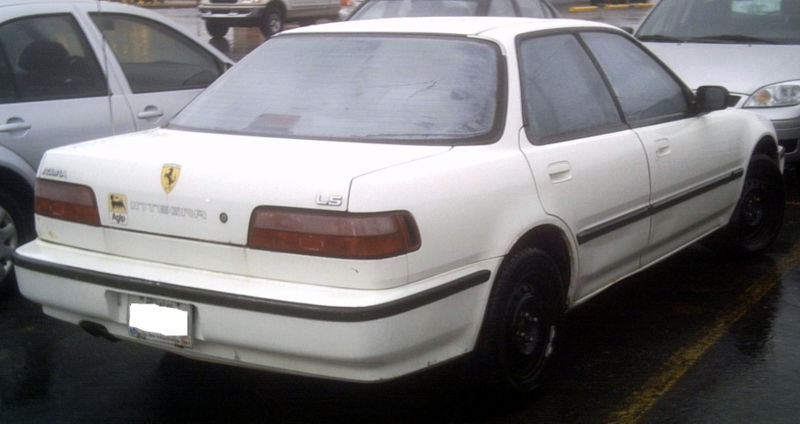Fart Car
From Wikislippy

Rice burner is a pejorative used initially to describe Asian-made � particularly Japanese-made � motorcycles and automobiles. Many variations have also been used, such as rice rocket for Japanese sport bikes.
More contemporary use of the term rice burner, along with the prefix rice, has taken on an alternate pejorative meaning for an automobile that has been modified to give impression of high performance, but does not necessarily have any high-performance capabilities. This practice is in direct contrast to the "stealth" or "sleeper" style of automotive modification, where a vehicle may have major performance modifications, but the appearance remains similar to that of a stock model. In this manner, the appellation can apply to any vehicle regardless of country of origin. The most commonly modified cars are sport compacts, but the term can apply to any class of vehicle, including trucks.
In the UK, cars so modified are said to have been "chavved up", due to the popularity of such non-functional styling modifications in chav culture. Another term is "maxed/maxxed", or "laxed/laxxed", the former being derived from the name of the magazine Max Power which mainly features such non-functionally-modified cars, the latter from the derogatory nickname "Lax Power" applied to this magazine.
In some circles, or even entire regions of North America, the terms rice car, ricer, or rice burner are used exclusively to describe Asian-made vehicles, whether they have been modified or not. However, as more types of cars began being used as a platform for modification, including German and American-made cars, use of the term rice is no longer restricted to Asian-made vehicles.
Contents |
[edit] Usage
Rice burner is used chiefly as a noun. Variations of this usage include ricer (both vehicle and driver), rice car, rice cooker, rice boy (used for the driver, a reference to the usual age demographic in question), rice mobile, rice rocket (for motorcycles), etc.
As an adjective, rice alone is primarily used and can apply to both vehicle and driver. Alternates include riced, riced out, riced up, and ricey. Ricing, a term usually not used by the modifier him/herself, is the present progressive of modifying a car in the described manner.
However, this term is completely relative to a person's opinion about what "rice" is. What one thinks is ricey, another may not. There is no concrete way to decide who's opinion is correct. With that said, the following is a generalized term referring to how it is commonly used by many people today.
Synonyms include: Tuner or Boy Racer, Referring to the car as well as the driver. Antonyms include: "Sleeper" or "Stealth", Referring to the car more than the driver.
[edit] Origin
The word "rice" in rice burner refers to the fact that the vehicles the term was originally applied to were of Japanese origin, and the fact that rice is a staple food in East Asian cuisine. Its earliest usage is still in question, but examples include the term referring to Japanese motorcycles in the early to mid 1980s, and muscle car enthusiasts' jokes that cars from Japan used engines powered by rice alcohol.
In the 1970s and 80s Japanese motor companies produced many popular performance cars and performance versions of existing cars. However, many of these were never exported beyond Asia. In the late 1980s and early 1990s, "grey imports" of Japanese performance cars became abundant in Western Europe and North America, such as the Toyota Supra. Many factors, such as parts being interchangeable, the low cost of obtaining a used imported car, and networking and e-commerce via the Internet all allowed the expansion of the practice of modifying a low-cost compact car. In the United States, this was in direct contrast to the domestic car production around the same time, where there was little widespread performance aftermarket for domestic compact and economy cars. In the United States, the focus was instead on sports cars such as the Ford Mustang or Chevrolet Corvette, or on classic muscle cars.
Because of their light weight and the increasing availability of low-cost tuning equipment, economy cars and compact cars exhibit high performance, at a relatively low cost in comparison to dedicated sports cars. As professional sporting and racing with such vehicles increased, so did more recreational use of these vehicles. Drivers with little or no automotive, mechanical, or racing experience would modify their vehicles to emulate the more impressive versions of racing vehicles with mixed results. A few detailed examples are below, but the most pointed out instances are aerodynamic attachments to a car, or loud exhaust systems.
On the contrary, many modern "Ricers" seemingly install aerodynamics to emulate the "more impressive versions" of a car. As a result, they are looked at as "posers". So even though some tuners are installing performance modifications to their cars, they are not getting the credit for their work. Partly because of the "Ricers", and partly because of the clash between Muscle cars and Ricers (AKA Tuners).
By the late 1990s, many contemporary Japanese sports cars were no longer being sold in North America. In the United States, this added to the exclusivity of these cars. The release of the PlayStation racing video game Gran Turismo acquainted North Americans with performance versions of compact cars that were never made available outside of Asia.
The movie The Fast and the Furious released in 2001 continued this exposure and expanded the visibility of automobile modification to the general public, and is generally thought to have resulted in an increase in the number of cars being modified.Template:Fact Two sequels of the movie series have been released since, with similar focus on modified vehicles.
The most immediate criticism of such modifications is usually aesthetic on the part of the person using the term rice. However, because of pop culture references to movies and the influence of video games, as well as the perceived demographic of "ricers", the criticism is often leveled at the driver.
In the United States, as American car companies began to follow suit with visual enhancement packages on older economy and compact car platforms, a similar phenomena could be seen trickling down to used American cars of the last generation. The term "American rice", "domestic rice", or "wheat burner" has been used to describe American-made cars that have been modified as described, but simply calling them rice is also commonplace. Non-performance versions of the Ford Mustang and Chevrolet Camaro, with V6 engines, might be found sporting large spoilers, graphics, colored tint, or other strictly visual modifications. The Performance V8 versions of these same cars may also be considered rice if their visual style leans too heavily towards the stereotype of a rice car or Japanese tuner car.
With the introduction of the Scion line from Toyota, auto manufactures have begun to actively court the "ricer" market in the United States. Scion television advertisements frequently feature modifications and interviews with Scion owners who have modified their cars.
[edit] Characteristics



"Ricing" a vehicle is meant to emulate the aesthetic work of independent automotive car tuning companies who modify more than just appearance, and to give an appearance of greater ability than the car actually has. Ricing is generally looked down upon amongst people who perform engine tuning, suspension tuning, and other performance racing modifications.


This is not meant to be a complete list of known ricing characteristics, nor do all rice burners have or are limited to these modifications. Almost all of these examples have practical performance or racing applications, but when these modifications are made improperly, done for pretense of being fast, or for the sake of visual appeal, the car in question will likely end up labeled as "rice".
Many of these modifications are nearly always found on high spec, comprehensively modified professional racing cars, but they are added as finishing touches to other extensive modification.
Common aftermarket modifications in this style can include but are not limited to:
[edit] Body modifications
- Aerodynamic-seeming or creatively-designed body kits, often with little function
- Wings and spoilers that serve no useful function.
- Fiberglass or plastic replicas made to look like Carbon fiber
- Non-functional hood scoops and roof scoops.
- Aftermarket scissor doors that open similarly to those of a Lamborghini
- Excessively large wheels ("rims"), often chromed or painted in bright colors
- Excessively lowered suspension
- Bumper canards fitted to the front bumper
[edit] Aesthetics
- Bright paint or interior, frequently in contrasting colors
- Decals and stickers for aftermarket parts (parts that may not even be installed on the car)
- Badging from other higher-performance vehicles or JDM factory racing developments such as Mugen or Nismo while the car may or may not have the branded parts installed.
- Imitation parts being represented as real parts. (i.e. fake Mugen shift knob being represented as a real one)
- Digital turbo, consisting of speakers installed under the car that emulate the sound of a turbo engine
- A loud, free-flowing exhaust system with a large cylindrical resonator at the rear of the car, known as a "fart cannon" or "coffee can"
- Large speakers that occupy the entire trunk.
[edit] Lighting
- Decorative neon and LED lighting in addition to the regular head/tail lamps and brake/turn signals, such as lighted windshield washer nozzles and tire valve caps, underbody neon lighting ("hover lights")
- "Altezza"-style lights or "Altezzas" (equally popular and known as "Lexus" lights in Europe), which have the colored light sources and reflective bodies contained within chrome housings and clear lenses
- Most Commonly, Simulated HID Xenon Bulbs with high kelvin color temperature, mounted in inappropriate halogen light housings causing excessive glare.
[edit] Improper Badging
- Type R or Si exterior and/or interior badges on Honda and Acura cars that are not Type R or Si models.
- MIVEC, VTEC or VVT-i exterior bading on cars not equipped with variable valve timing technology
- Applying the badge of higher trim level models (such as "limited" or "sport") on an economy trim level car of the same model
- Lexus/ Acura/ Infiniti badges on models sold under Toyota/ Honda/ and Nissan or vice versa
- V6 badge on cars with I-4 engines
- Mitsubishi badges on Proton cars and Daihatsu badges on Perodua cars
[edit] Identity crisis
While not always associated with rice, an "identity crisis" can occur when decals, badges or other identifiers from one type of vehicle appear on another vehicle of the wrong type, or lacks the specifications indicated by the accessory. Examples could include a Honda Civic with a TYPE-R which hasn't been available in North America. A cross-manufacturer example would be an Impreza WRX sporting a VTEC sticker (a Honda branded technology).
Identity crisis is not limited to Japanese cars, however. A Ford Mustang might be found with "GT-R" badging from the Nissan Skyline GT-R. A muscle car badge might be placed on a vehicle that is not a muscle car (e.g. a Yenko emblem on a non-muscle car Chevrolet). A base model BMW 5 series car may sport M5 badging. Mercedes-Benz vehicles may sport AMG badging while the car is simply a de-badged base model. Volkswagen has also been the victim of cutting together the VW GTI, Golf, and Jetta.
This term should not be confused with the process of re-badging badge engineered cars. Badge engineering is the process by which a model from one car company is sold as a model of a different company. This operation often happens when cars from companies belonging to conglomerates (eg. General Motors) are sold overseas. One example is the Opel-produced Vectra, which was sold in Australia as a Holden, in The Americas as a Chevrolet or Pontiac and in the UK as a Vauxhall.
[edit] Legitimate uses
There are some car owners who are legitimately interested solely in visual appeal rather than any perceived performance, as there are custom car shows and competitions with focus on innovative design and expression of the driver. Such shows may be used to display artistic paint schemes or even radical structural body modification of the vehicle. The difference between this and a rice-burner is that the rice-burner's modifications are made under the pretense of higher performance.
Almost all of the examples given have a legitimate performance or racing application that can be seen in professional motor sports. Carbon fiber body panels (as seen on many motorsport event vehicles) are extremely light and reduce overall vehicle weight. True HID lamps improve night vision for rally (WRC) and endurance racing. Wide, lightweight wheels can improve cornering for SOLO events.
[edit] Non-automotive applications
The terms "rice rocket", "riced-out" and "ricing" are sometimes used to describe computer case modifications which serve to make the computer look fast without actually improving its performance. As with "riced" cars, neon lights and adhesive decals can be installed by the consumer but some consider this tacky.


